Platycodon grandiflorus
Balloon flower, Platycodon grandiflorus, is a native of the Russian Far East, China, Japan, and Korea that has become a garden sensation in the United States.
A member of the Campanulaceae family that includes bellflower and lobelia, its common name derives from the puffy balloon-like buds that burst open into starry bell-like blossoms.
In this article, you will learn how to grow and care for balloon flower in your landscape.
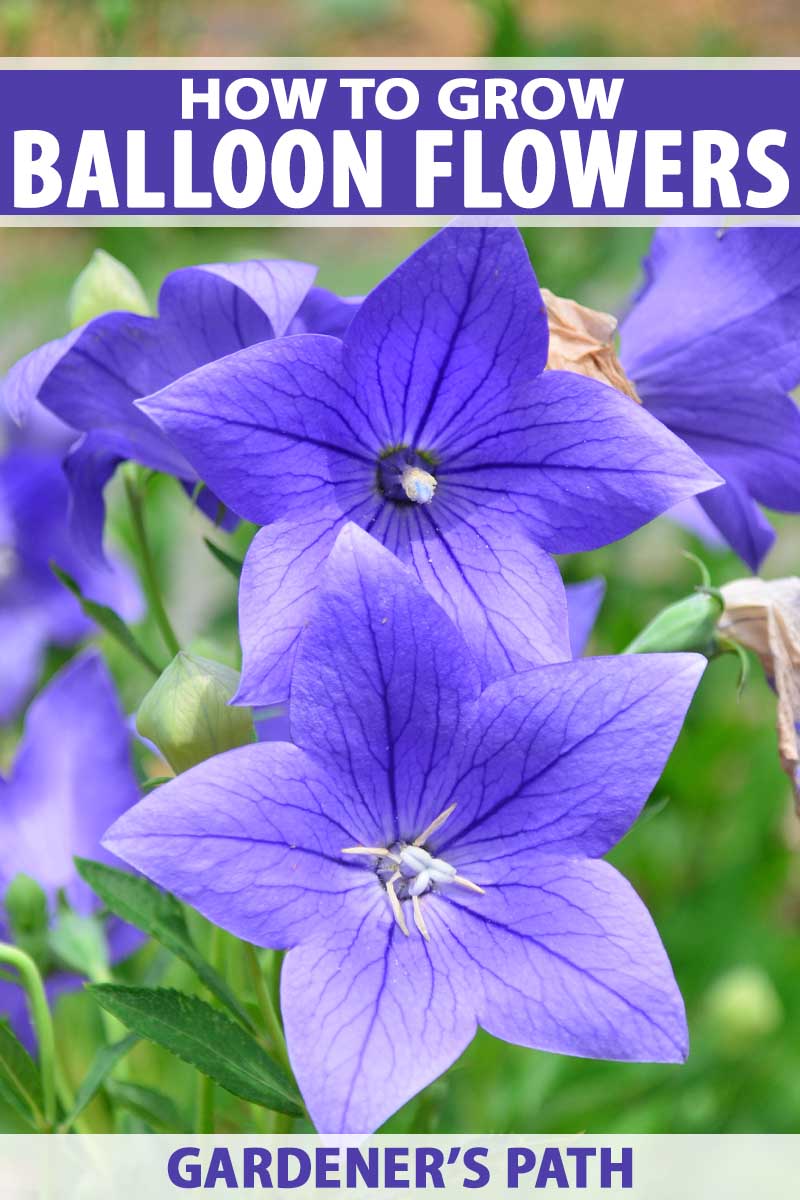
We link to vendors to help you find relevant products. If you buy from one of our links, we may earn a commission.
Here’s what’s in store:
What You’ll Learn
What Are Balloon Flowers?
Although P. grandiflorus is not a native blue flower, its hardy, disease-resistant nature and vibrant perennial blossoms have made it a jewel of American gardens.
Also called common, Chinese, or Japanese bellflower, P. grandiflorus grows in clumps that fill in densely, and is the perfect plant for a sunny border garden. This herbaceous perennial is suitable for gardeners in USDA Hardiness Zones 3 to 8.
The two- to three-inch flowers bloom in various shades of blue, as well as pink and white. Some have prominent veining of the petals.
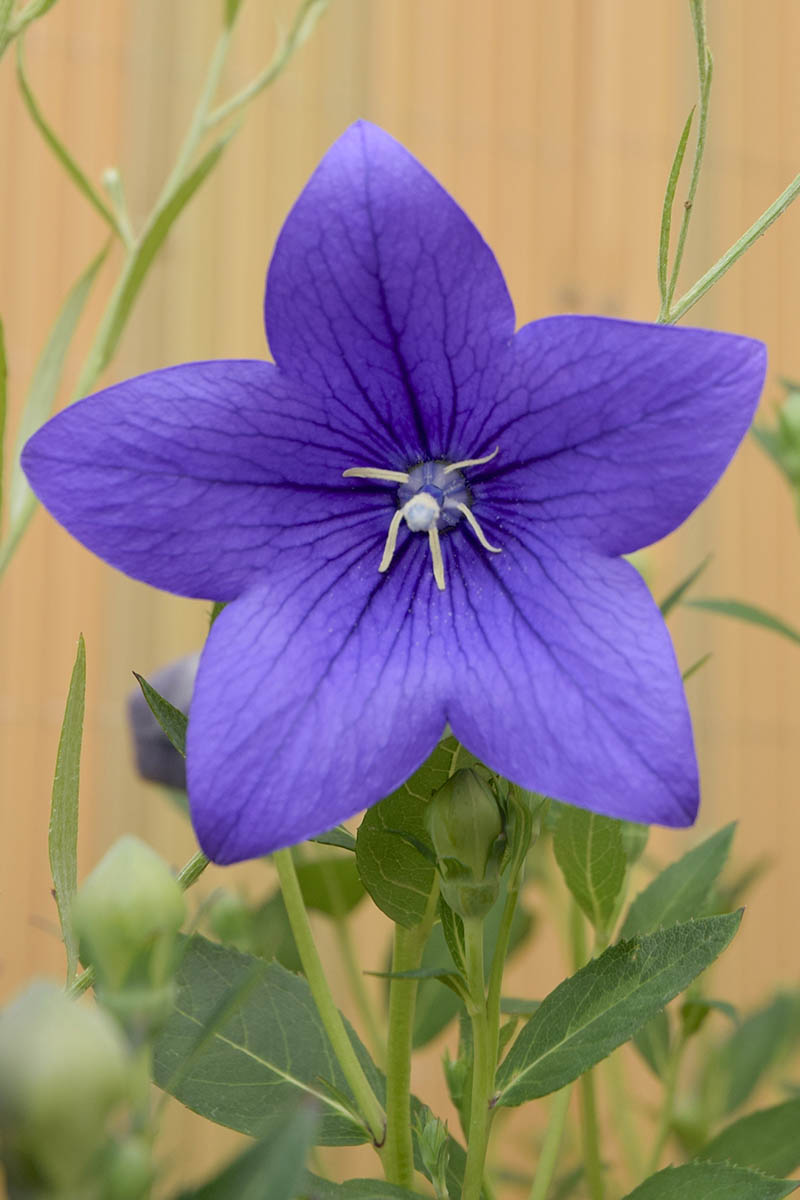
There may be one or more blossoms on each upright stem. In the bud stage, they resemble little balloons begging to be popped. When they open up, they resemble star-like upturned bells.
The leaves are thick, and green to blue-green in color. They are lance-shaped with serrated margins.
P. grandiflorus thrives in organically-rich, loamy soil that’s well-drained and moderately moist. It has fleshy taproots that are easily damaged if plants are disturbed.
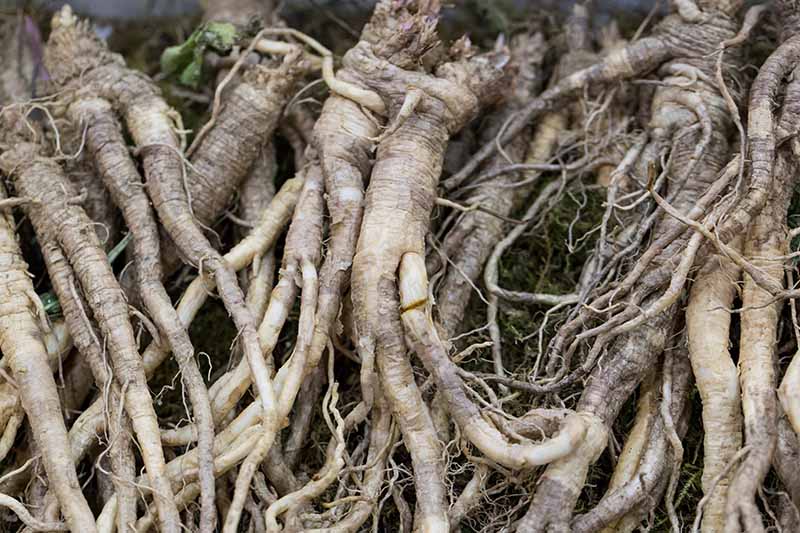
The roots are not aggressive, but this plant self-sows with vigor, spreading via new shoots that pop up in the fertile ground each spring.
Plant sizes vary. The true botanical species, as found in the wild in its native lands, may reach or even exceed 36 inches tall and 18 inches wide at maturity.
Cultivated varieties include dwarf plants that are four to six inches tall and equally wide, as well as medium-sized specimens that measure 12 to 18 inches tall and wide.
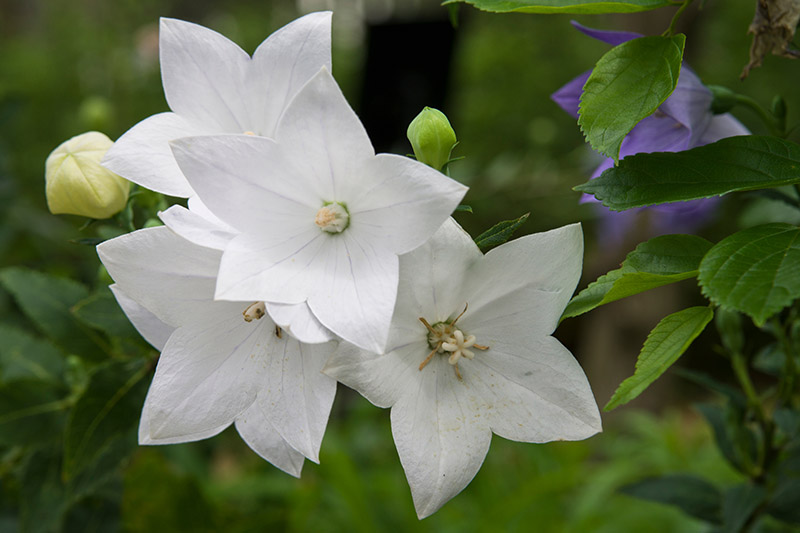
With regular deadheading, plants bloom prolifically through the summer.
Per the California Poison Control System, P. grandiflorus is non-toxic to humans and animals.
The edible roots have long been pickled and preserved, and used in herbal remedies and dietary supplements, to provide anti-inflammatory, antitussive, and digestive benefits.
Balloon Flower Propagation
P. grandiflorus may be propagated from seed, by stem cuttings, or from nursery starts in the spring.
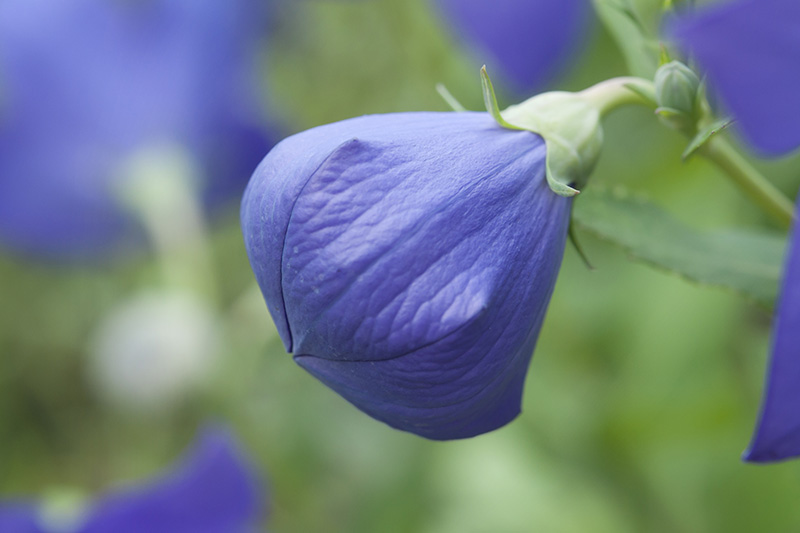
Other propagation methods are not recommended for this plant.
Some folks try to divide P. grandiflorus. However, the divisions are rarely successful due to the inevitable root damage.
Also, you may sometimes find dormant bare rootstock for sale.
As the roots are fragile and resistant to transplant, this method may not be worth the investment, especially when plants are so easy to direct sow and grow from seed.
Let’s take a look at each of the recommended propagation methods.
From Seed
Start seeds indoors six to eight weeks prior to the last average spring frost date for blooms in the first year.
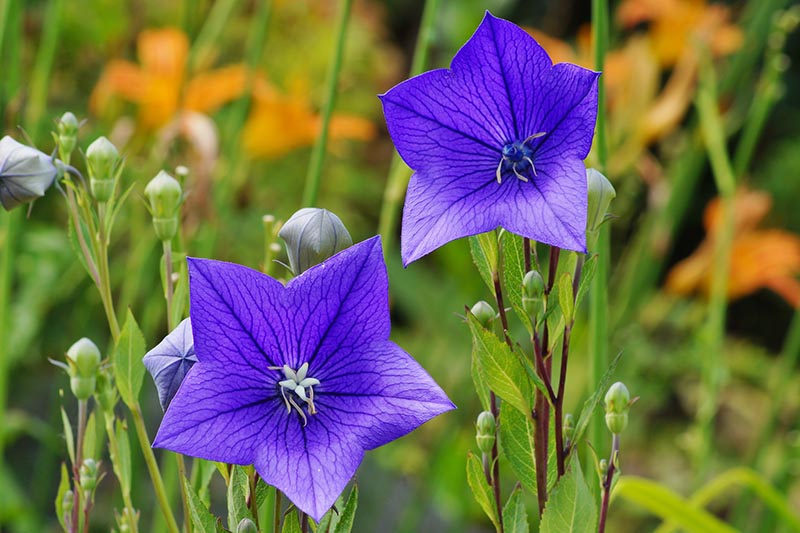
P. grandiflorus seeds need light to germinate, so place them on the surface of moist soil without covering them.
When the seedlings have two sets of true leaves and the danger of frost has passed, you may gradually acclimate them to the outdoors.
Give them a few hours of fresh air and sunlight each day for about three to five days. This is a process called “hardening off.”
After hardening off, you can transplant the seedlings to the garden, taking care not to disturb the fragile roots.
Dig a hole the same depth and width as the root ball.
Keep the soil surface of the seedling even with the ground soil surface, neither burying nor elevating the seedling, to minimize transplant stress.
You may also direct sow seeds outdoors after the last average spring frost date, or at any time during the growing season, but they may not produce flowers until the second year.
Moisten the soil and sprinkle your seeds every few inches throughout the planting area. Do not cover them.
Maintain even moisture, but do not let the soil become waterlogged.
Once they have several sets of true leaves, thin the seedlings to accommodate plants’ mature dimensions.
This is the best propagation method, as it will not put any stress on the delicate roots.
For both methods, maintain even moisture but avoid oversaturation while seeds germinate and plants become established in the garden.
From Nursery Starts
Transplant nursery starts to the garden in early spring for flowers the first year.
You may plant nursery starts at any time during the growing season to ensure flowers in the second year.
When you transplant, dig a hole the same depth and width of the root ball, and be sure to keep the pot soil level even with the ground soil level.
Remove the plant gently from the container and do not disrupt the roots.
Maintain even moisture before and after transplanting.
From Cuttings
In the spring, you can take soft cuttings of growing stem tips to root and plant out.
Use clean, sharp pruners to cut off about four inches of a stem. Pinch off enough foliage to reveal about two inches of bare stem at the bottom.
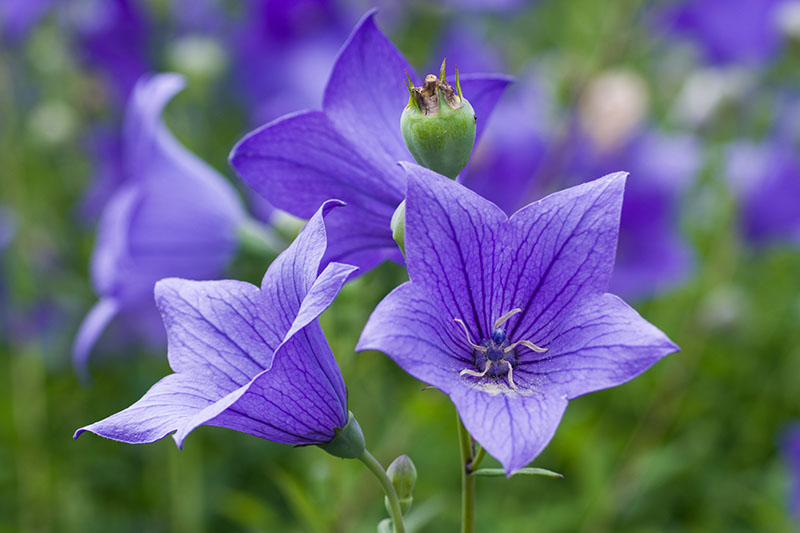
Dip the bare stem in powdered rooting hormone and then place it into a container of potting medium. Maintain even moisture, but do not overwater.
The appearance of leaves is evidence of root growth.
Transplant the rooted stem to the garden, taking care not to disturb its delicate roots.
Plant it at the same depth as the container in which it was growing.
How to Grow Balloon Flowers
Now that we’ve talked about starting plants, let’s move on to establishing them in the garden.
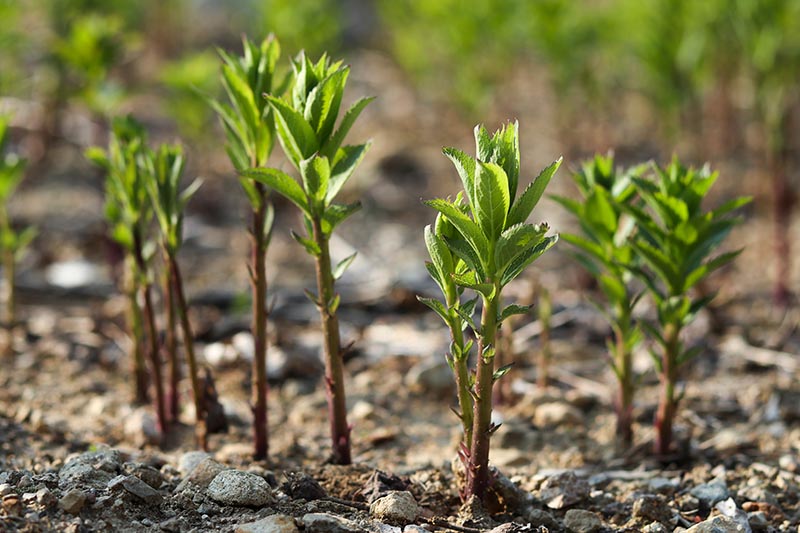
Balloon flowers require a full sun to part shade location.
The ideal soil is organically-rich and loamy, with a pH that falls between about 5.5 to 7.5.
You may conduct a soil test to determine the characteristics of your earth. Add lime to lower acidity, or sphagnum peat moss to increase it, as needed.
The soil should be well-draining. If you find your soil is dense and clay-like, you may add builder’s sand or leaf mulch to loosen it and improve drainage.
Leaf mulch may also increase the acidity.
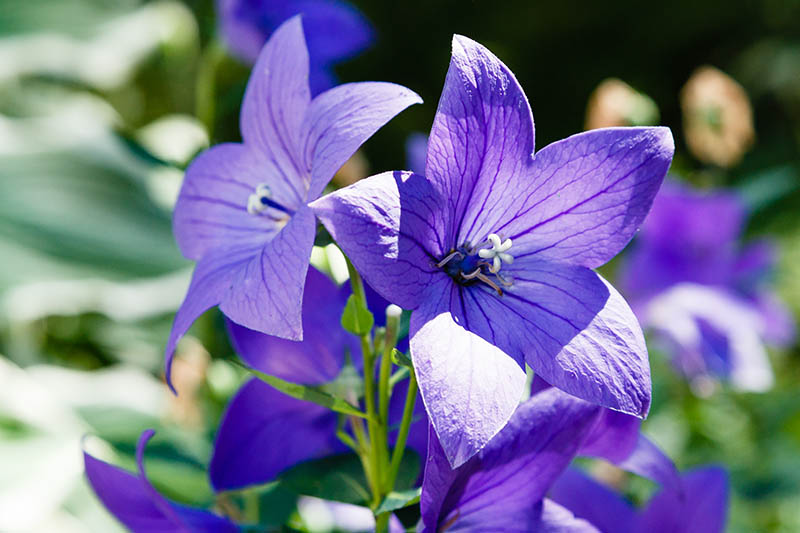
Work the soil to a depth of about 10 to 12 inches, amending it as needed to achieve the appropriate pH and good drainage.
For nursery starts, seedlings, and rooted cuttings, space plants to allow for their mature dimensions. Take care not to disturb the taproots during transplant.
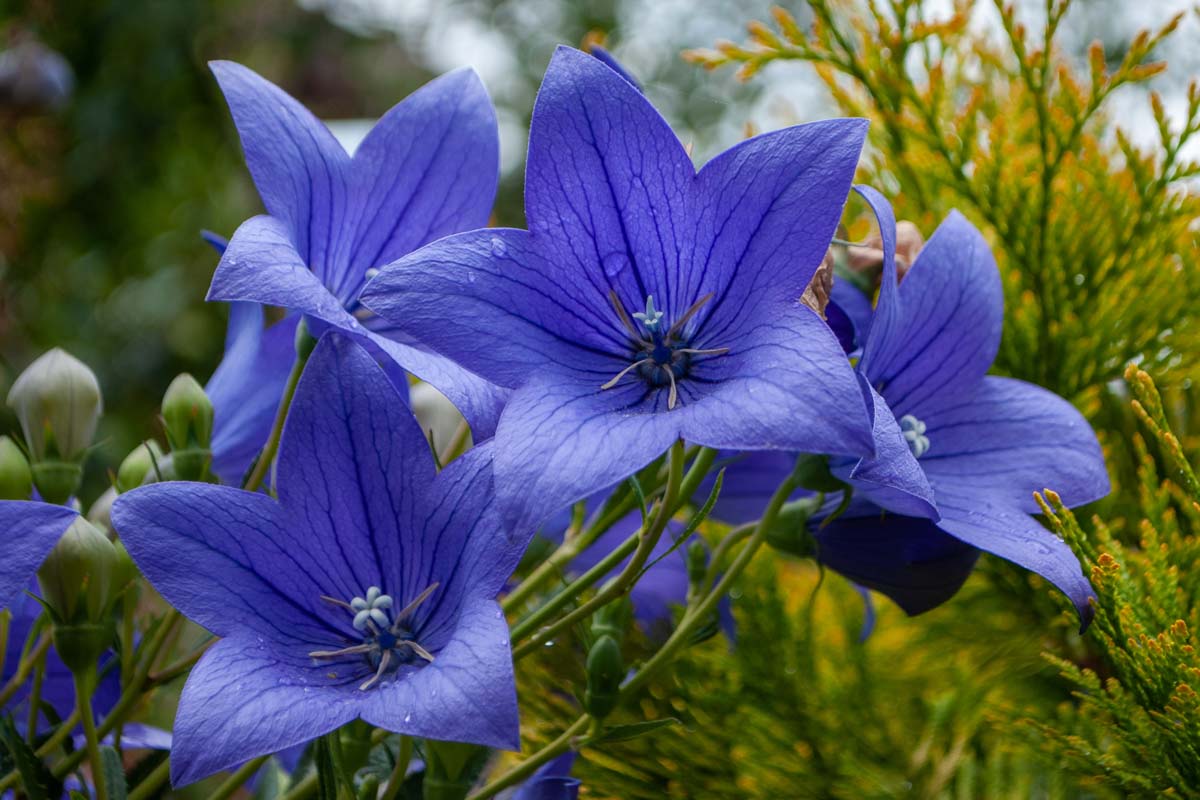
Provide consistent moisture, but always avoid standing water, until plants are well established.
You may apply an all-purpose slow-release granular fertilizer at the time of planting if desired.
A layer of mulch may help to retain moisture, with the bonus of inhibiting weeds that may compete for water and nutrients.
For container gardening, cultivate dwarf varieties.
Select pots that are at least two inches wider than the mature widths of the plants, and with a depth of at least 10 to 12 inches to accommodate the taproots.
Be sure the pots drain well. Keep them uniformly moist, but not soggy, and remember that containers will dry out much quicker than ground soil.
Growing Tips
This hardy perennial is easy to grow, especially when you start with seeds.
Remember these three keys to success:
- Sow seeds on the surface of moist soil so they have the light they need to germinate.
- Disrupt plants as little as possible to avoid damaging the taproots.
- Provide good drainage and use mulch to maintain adequate moisture without oversaturation.
Pruning and Maintenance
This low-maintenance plant does well on its own in ideal conditions and requires very little intervention once established.
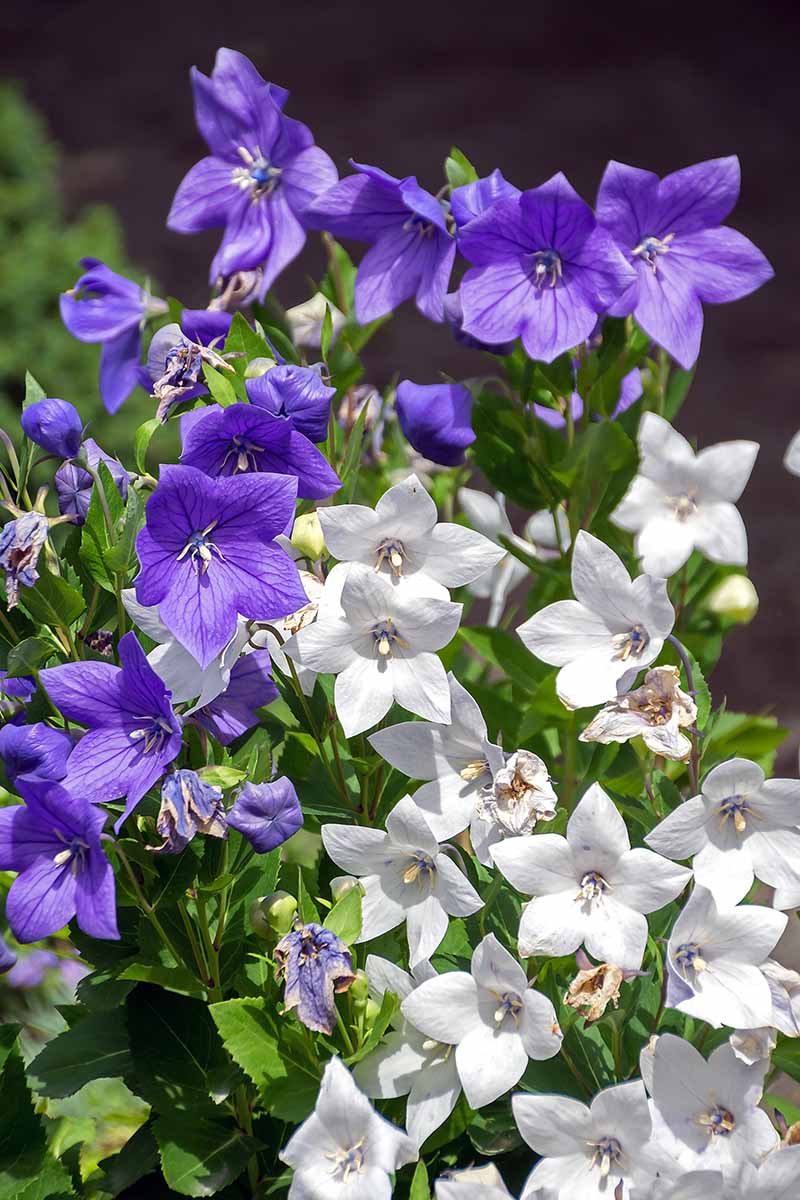
However, there are two issues you may have to deal with: “leggy” stems and self sowing.
Leggy Stems
A very common complaint about this plant is that the stems of tall varieties tend to get “leggy” and grow horizontally instead of vertically.
Here’s how to manage plants for more upright growth:
Cut all stems by one-half in late spring to encourage more branching, and compact, bushy growth.
In fall, after the growing season is over, you may also cut all of the dead stems to the ground. You can also prune in early spring, just as the new growth appears.
If you choose to prune in early spring, take care not to damage emerging shoots.
Also, don’t fertilize if your soil is especially rich, because too much nitrogen can cause legginess.
And finally, if you decide not to take proactive measures, simply use stakes to support the stems and keep them upright.
Self-Sowing
A vigorous self-sower can be a problem.
Either give this plant a space of its own to naturally reseed at will, or plan to dig up random seedlings every spring. Some are sure to jump the garden boundary and end up in the lawn, if proximity permits it.
You can also limit self-sowing by deadheading spent blossoms throughout the growing season, and/or removing all stems after blooming finishes and before seeds drop.
You may save harvested stems to dry for seed collection. However, many balloon flowers are cultivated hybrid varieties, and they are likely to produce results that differ from their parent plants.
Fertilizer
Fertilizing is optional. Apply an all-purpose slow-release granular plant food in early spring if desired.
Organically-rich soil provides adequate nutrition, and products that are high in nitrogen may contribute to legginess.
Moisture
Established plants have deep taproots and require little supplemental water.
They exhibit above average drought tolerance, but in the event of a prolonged dry spell, water deeply once a week.
Balloon Flower Cultivars to Select
When shopping for balloon flowers, you may come across the true botanical species, but more likely, you’ll find cultivated varieties.
You can find packets of 50 seeds of the species plant, P. grandiflorus, available from Earthbeat Seeds.
Here are some you are sure to like:
Astra Double
P. grandiflorus ‘Astra Double’ is a dwarf variety with a mature height of six to 12 inches and width of six to nine inches, making for a compact plant that is easy to manage.
Flowers measure three inches across and boast a double row of lavender-blue petals. They are especially prolific with consistent deadheading.
P. grandiflorus ‘Astra Double’
This is a hardy, pest- and disease-resistant cultivar.
The petite stature of this type makes it a good choice for containers, the front of mixed beds, and along the edge of borders.
Find P. grandiflorus ‘Astra Double’ plants now from Nature Hills Nursery.
Rose
P. grandiflorus ‘Rose’ is also a compact plant that matures to a height of 18 inches, and a width of 12 to 18 inches.

The three-inch blossoms are pale pink and have one row of petals.
This is another hardy, pest- and disease-resistant choice.
Low-profile balloon flowers are unlikely to require staking, and are well-suited to container gardening as well as bed, border, and rock garden placements.
Remember to deadhead spent blossoms to encourage optimal blooming.
Find P. grandiflorus ‘Rose’ seeds now from Outsidepride via Amazon.
Fuji Blue
A taller cultivar, P. grandiflorus ‘Fuji Blue’ generally tops out at 18 to 24 inches tall with a spread of 12 to 18 inches.
The flowers have a single row of deep blue petals, and measure between two and two and a half inches across.
Well-suited to mid-bed placements, this type may require staking.
‘Fuji Blue’ may also produce double blooms. Variations are possible as most cultivars are seed-grown, according to experts at the Chicago Botanic Garden.
Find P. grandiflorus ‘Fuji Blue’ seedlings from your local nursery.
Sentimental
P. grandiflorus ‘Sentimental’ is a dwarf cultivar with mature heights ranging from six to 12 inches and widths of 12 to 18 inches.
The flowers have a diameter of three inches and a single row of blue petals.
The wider spread of this low-profile option makes it an especially good choice for border edging.
Find P. grandiflorus ‘Sentimental’ plants now from Nature Hills Nursery.
Managing Pests and Disease
P. grandiflorus is not prone to problems with pests or disease, however, as I always say, your best defense is a healthy plant.
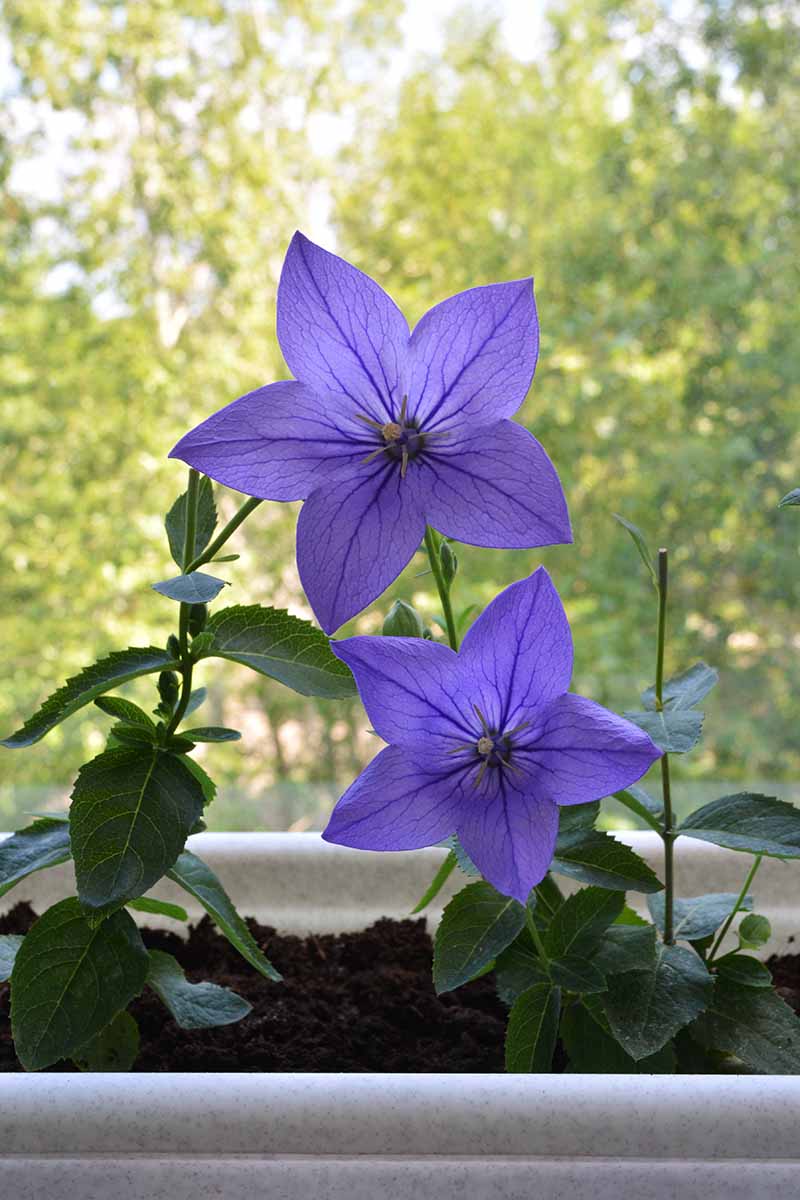
Conditions that are too wet may make it vulnerable to pests such as slugs and snails.
In addition, if plants sit in puddles of water, they may be susceptible to root rot.
Avoid problems by providing adequate drainage, and don’t water established plants unless there is insufficient rainfall combined with high temperatures.
Best Uses of Balloon Flowers
If you’re looking for something really unique for your mixed beds, borders, and containers, this plant is one to consider.
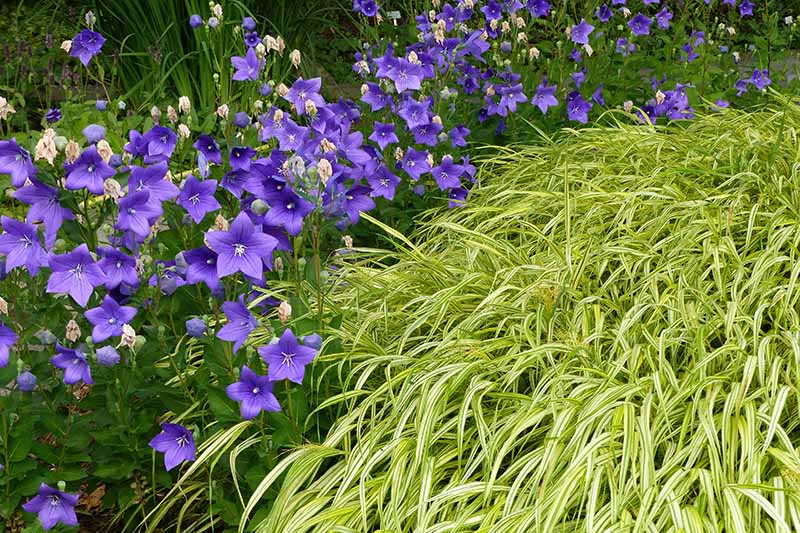
I’m especially partial to the blue flowers because they are eye-catching for their color alone.
Add to this their balloon-like buds and starry bell-shaped blooms, and you have a specimen that’s going to be noticed.
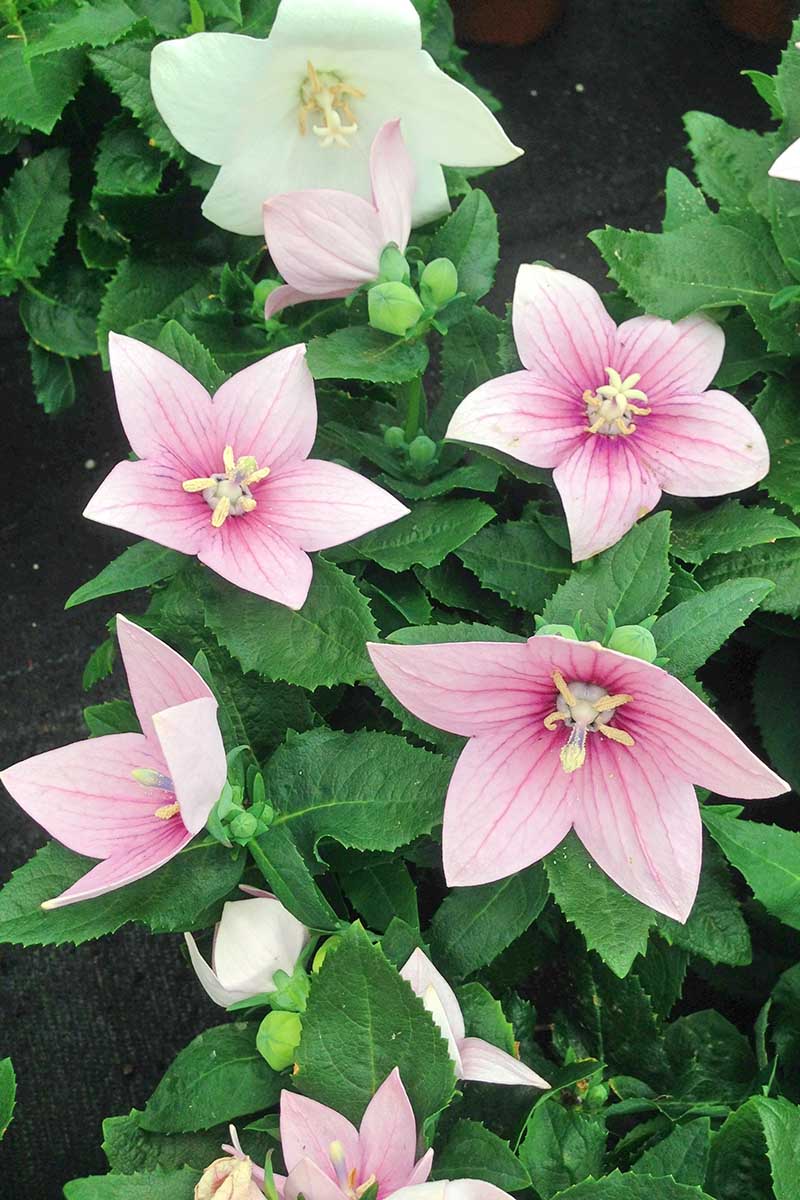
Dwarf types are easy to grow in containers, rock gardens, and at the front of beds and borders, where a low, compact profile is appreciated.
Medium-size varieties hold the middle ground of perennial beds, while taller species plants anchor rear positions with their sturdy stems (which may need staking).
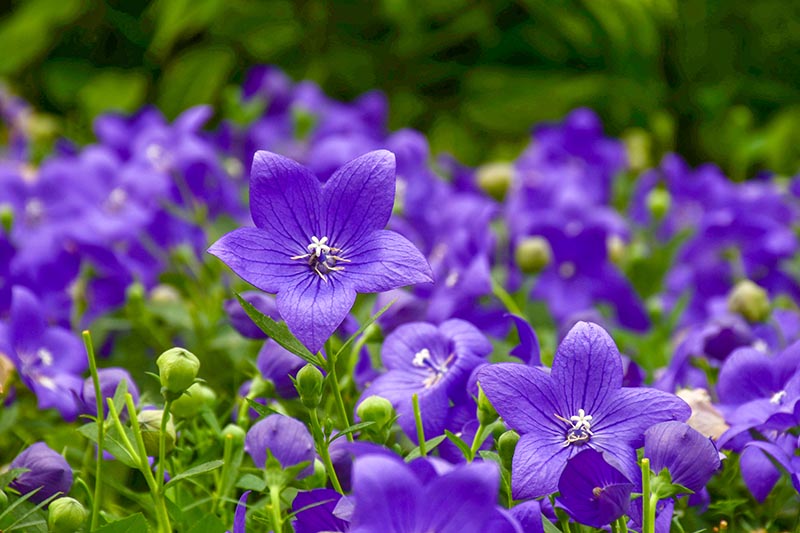
Companions that play well with P. grandiflorus include bee balm, black-eyed Susan, blazing star, daylily, and lily turf.
It is important to choose plants with similar water requirements, to avoid oversaturating your balloon flowers because a neighboring plant has dehydrated.
Quick Reference Growing Guide
| Plant Type: | Herbaceous perennial | Flower / Foliage Color: | Blue shades, pink, and white/ green to blue-green |
| Native to: | Asia, Russia | Tolerance: | Deer, drought, heat |
| Hardiness (USDA Zone): | 3-8 | Soil Type: | Organically-rich loam |
| Bloom Time / Season: | Summer | Soil pH: | 5.5-7.5 |
| Exposure: | Full sun to part shade | Soil Drainage: | Well-draining |
| Spacing: | 4-18 inches | Attracts: | Bees, birds, butterflies |
| Planting Depth: | Surface sow | Companion Planting: | Bee balm, black-eyed Susan, blazing star, daylily, lily turf |
| Height: | 4-36 inches | Uses: | Border edging, containers, perennial beds, rock gardens |
| Spread: | 4-18 inches | Order: | Asterales |
| Growth Rate: | Moderate | Family: | Campanulaceae |
| Water Needs: | Moderate | Genus: | Platycodon |
| Maintenance: | Low | Species: | grandiflorus |
| Common Pests: | Snails and slugs | Common Disease: | Root rot |
Plucky and Playful
Balloon flower is a not a fragile face in the crowd, but a sturdy-stemmed beauty that stands up to repeated deep pruning for a compact and manageable form.
It asks little in the way of water once established, and while it loves to self-sow, well-chosen planting locations and adequate deadheading can minimize the effects of its exuberance.
Ask the kids to help you add this perennial gem to your outdoor living space.
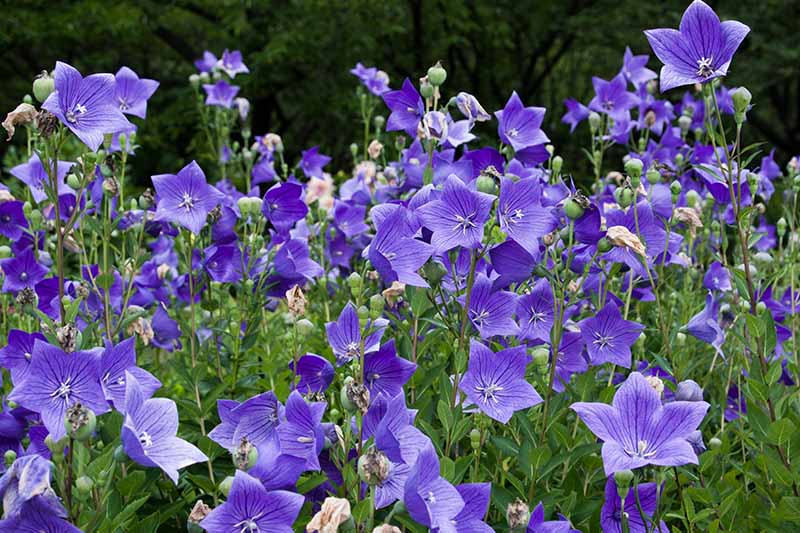
It’s a great choice for gardening with children because it’s easy to grow, comes back year after year, and the inflated buds never cease to delight.
Will you be planting P. grandiflorus in your garden this year? Let us know in the comments section below, and feel free to share a picture!
If you like vigorous blue flowers, you’ll want to read these guides next:
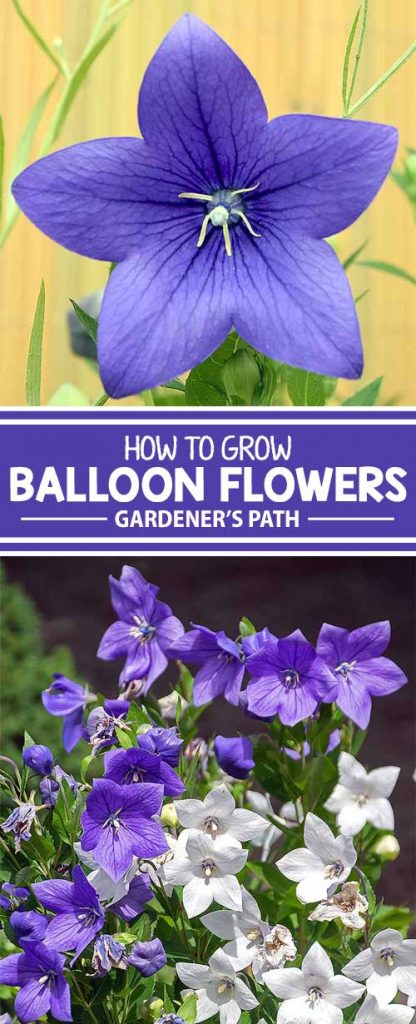
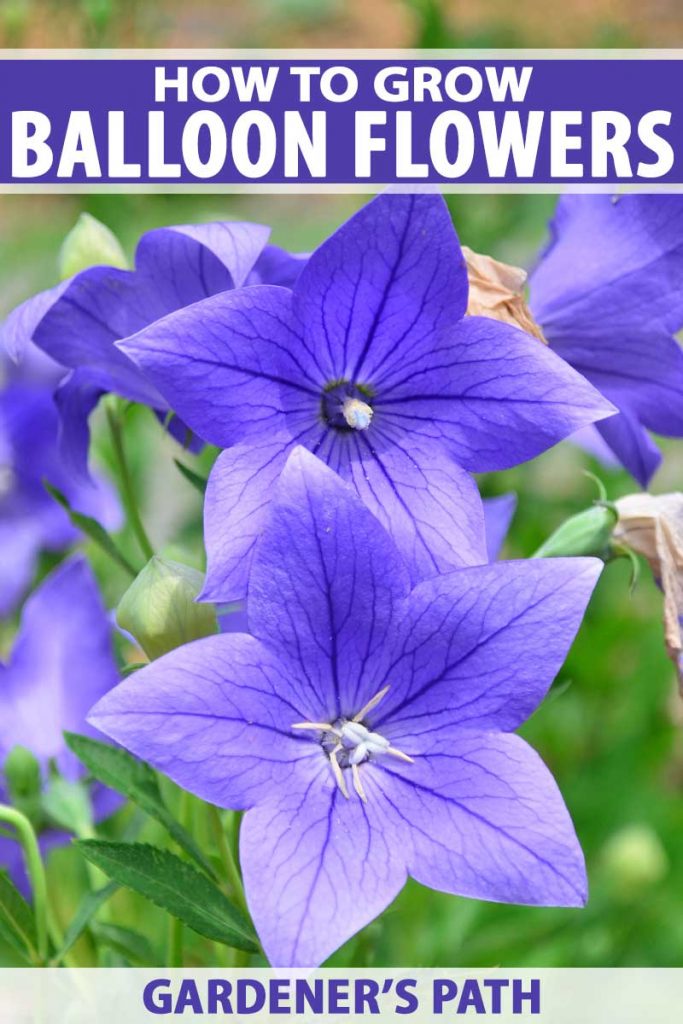
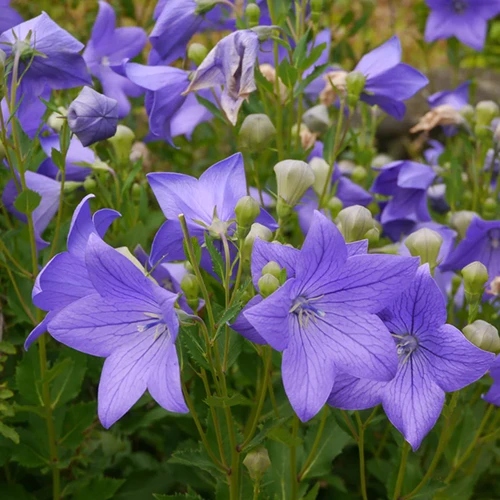
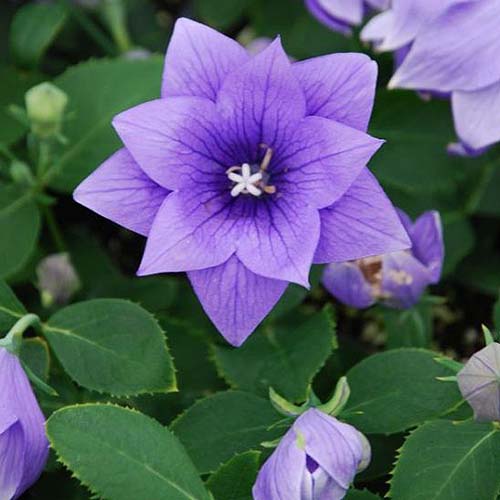
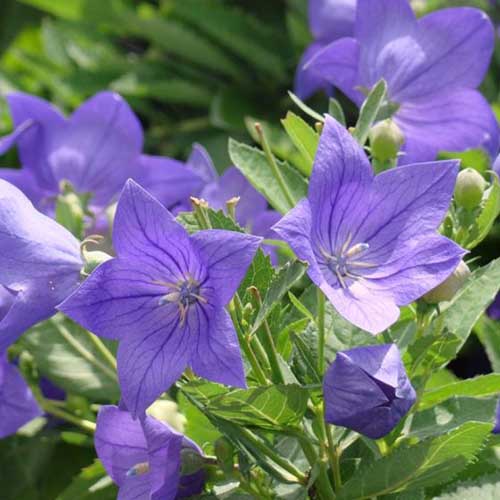


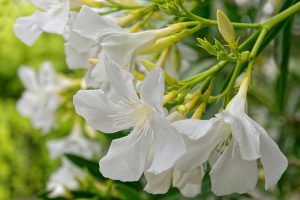
Is it possible for me to have one indoors from year to year? Are there different techniques to enable flowering again after winter with an indoor potted Platycodon?
Hello, Erick – Thank you for your question. Most commercially available Platycodon grandiflorus varieties are intended to grow outdoors, where they spread by vigorous runners and often exceed two feet in height. If you want to grow one as a houseplant, look for a compact/dwarf variety. – Place your plant in a sunny location. – Keep the soil moist, but not dripping wet. And when you water, avoid the leaves and aim for the soil. – Pinch off and discard spent blossoms. – Ensure that your plant is in optimal condition for blooming by applying an all-purpose, slow-acting granular fertilizer.… Read more »
This beautiful flower popped up out of nowhere last summer in of all places my boxwood shrub! There are two adjoining plants this season, the taller one being 55 inches high! Has anyone heard of them growing this tall? They are definitively astra double blue balloon flowers (Platycodon grandifloris).
Wow, Mark! Some Astras top out at only 10 inches. I have read about some 47-inch Komachis. Maybe you have an amazing hybrid, or super-soil!
I have lots of photos if you’re interested!
My pictures are posted on Facebook.
Hi Mark –
You’re welcome to post one on the Gardener’s Path Facebook page to share with our readers.
I’m gonna try it. Saw them in nursery and gonna give a try. They were listed as a top 10 perinneal for clay soil on another site? Any insight
Hi Angela –
While balloon flower prefers rich loam, you might try adding a little humus or compost and some sand to your clay soil. Provided it drains well, you may get acceptable results.
When to plant?
Hello Helen –
Start balloon flower seeds indoors in early spring and transplant outdoors after the danger of frost has passed. Alternatively, you may place plants directly into the garden in late spring or early summer. Seeds will need two years to produce flowers. Plants should bloom in the first year.
I’m transplanting these. We’ve moved to the woods near a lake in North central Texas, so I’m wondering if the deer are going to eat them. They’re very effortless, & I love the blue.
I’d love to have some white ones!
Hi Melva –
The deer usually leave balloon flower alone.
Love these and luck with them on my deck.
I was wondering about keeping mine in a pot larger than it came in. How do the ones on your deck do in pots?
Hi Vicki –
We’re glad you are enjoying balloon flower as a container plant on your deck. That’s a great way to keep it right where you want it.
I love my balloon flowers but once they are 12-15 inches, the plants don’t stand up. They can’t support the weight, I guess. Do I need to stake them?
Hi Denise –
You may stake balloon flowers that become leggy. You may also deadhead throughout the growing season, and prune entire stems for a more compact appearance. In addition, at the end of the growing season, or early next spring, you may prune old growth to make way for new, creating a more compact size from the start.
If you prune the old spent flower bud, do you not need the seeds for regrow the following year?
Hi Liz –
You may save the seeds if you like, but it’s not necessary. The roots winter over and the plant comes up again next year.
I have a blue ballon flower plant that has increased in size since I planted it three years ago. This year I am getting multiple flowers, but the stems all grow away from the center before turning up and so the plant itself does not look very pretty. Would this be because
the plant does not get afternoon sun?
Hi Cheryl –
You can cut balloon flowers back in early spring, before they start to grow again, to encourage a compact growth habit. If you don’t, they do tend to get leggy. Try staking them with twine and bamboo sticks, to hold them upright and create a neater appearance. Balloon flowers like full sun, but are very tolerant of partial shade, so the lack of afternoon sun shouldn’t be a problem. Thanks for reading and best of luck with your gardening!
I read they do great with just afternoon sun. I planted 5 small plants last fall here in Colorado zone 5 on the west side of the house and though they were slow to make an appearance this Spring I just was rewarded with my first blossom.
Hi Susan-
Your flower is beautiful!
Balloon flower does best in full sun, but does tolerate part shade. In warm locales, it does best with afternoon shade, but in your location, where it’s cooler, it can take all the sun it can get. So glad to hear you’re having success!
I was fortunate to acquire some starts of the blue and also the white balloon flowers last year. They have done extremely well and I love how they add interest to my gardens.
Hi Cindi –
Thanks for sharing. Enjoy!